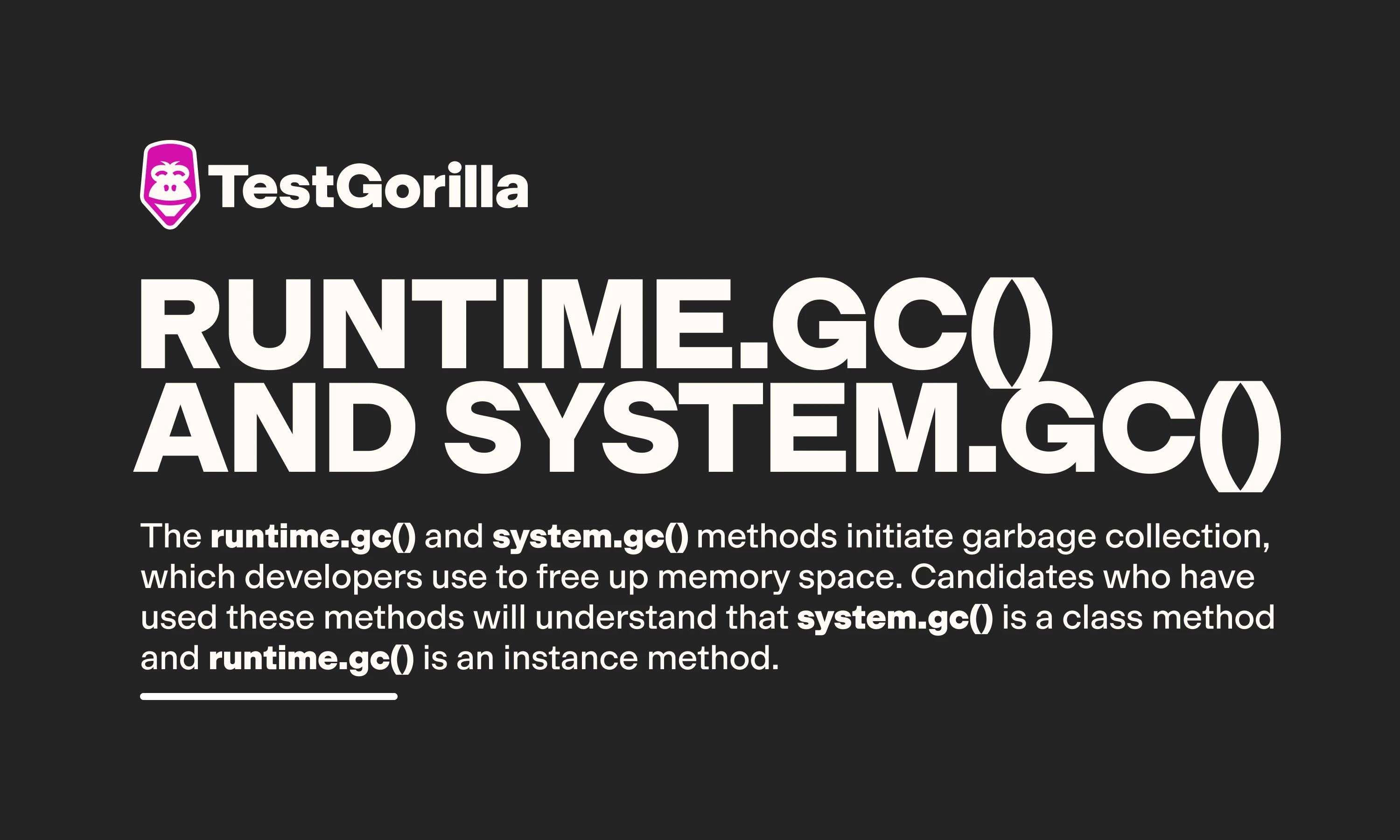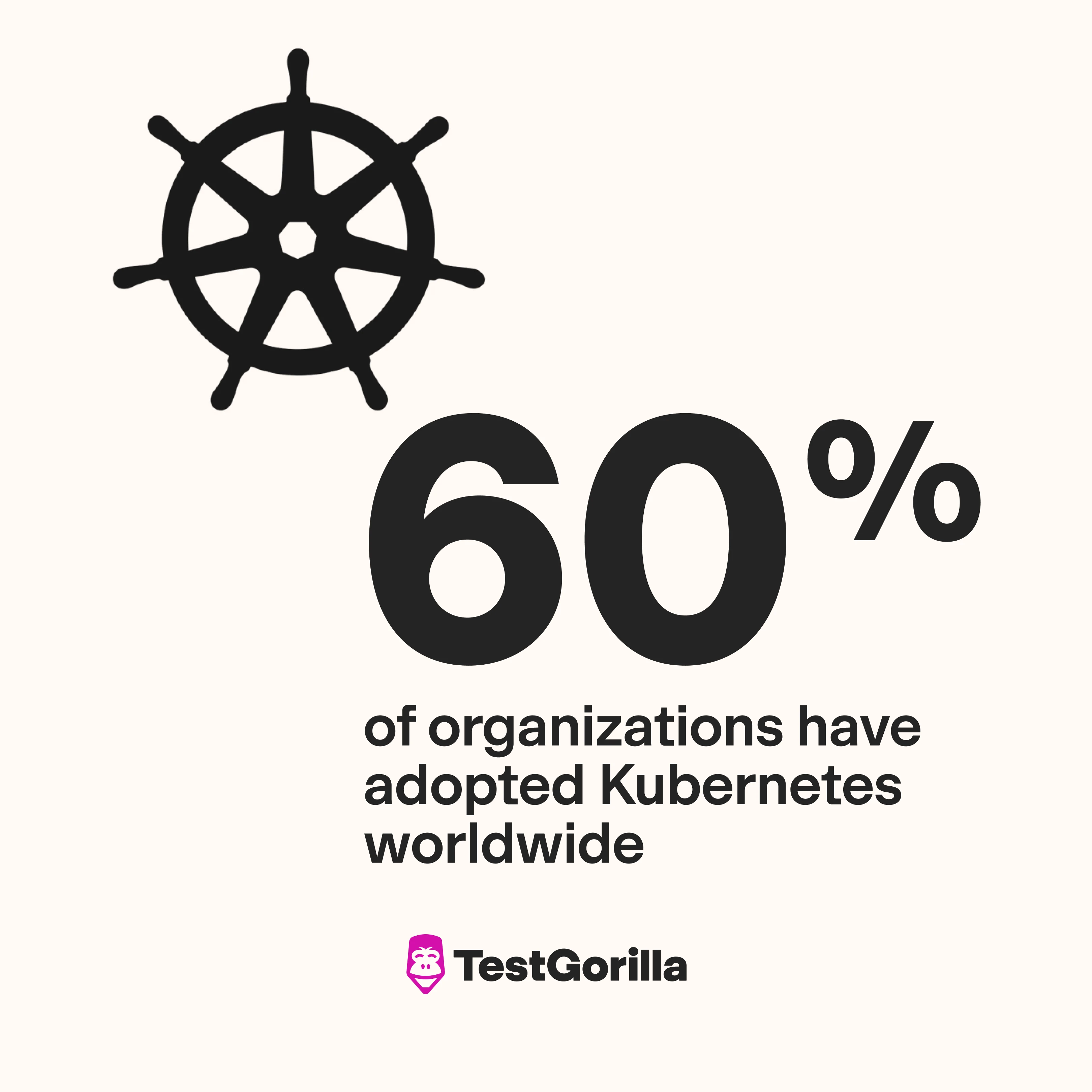25 senior Java developer interview questions to ask your programmers
Find and recruit top senior Java developers with TestGorilla
Senior Java developers have a vast skillset that makes them proficient in programming with Java. Their duties are diverse, from fixing bugs and coding to designing and assisting junior Java developers. If you’re hiring a software engineer or developer, assessing as many of these skills as possible and their technical knowledge is critical.
Skill assessments that feature programming tests are a step in the right direction to begin evaluating their skills, but interviewing is also essential.
You need interview questions to encourage candidates to talk about their skills in an interview. But which interview questions are best to ask a potential senior Java developer?
It’s easier than you anticipate to find some. Check out the 25 questions gathered in this article to assess your candidates’ abilities when you meet them.
25 senior Java developer interview questions about skills and technical knowledge
Ask your candidates some of these 25 Java developer interview questions to learn more about their proficiency and experience using Java.
1. Java is a platform-independent programming language. Can you explain why?
Java is a versatile programming language that is the second most popular (second to Python), partly due to its platform-independent status. It’s a platform-independent programming language because developers can run their applications on any platform.
Your candidates should know that programmers don’t need to rewrite data for each platform on which they want to run their programs. They’ll also be able to name several platforms compatible with Java and don’t require data recompiling methods. Some of these include Linux, Mac OS, and Windows.
2. Can you tell us what happens to Java source files in the JVM?
A Java virtual machine executes bytecode using a source file. During the process, the JVM considers the instruction lengths of the underlying hardware platforms, which makes the virtual machine versatile and efficient.
The JVM translates the source files into bytecode files, which enables the virtual machine to generate the bytecode and convert a program into machine-level assembly.
3. How would your engineering manager rate your Spring framework skills?
Ideally, senior Java developers should have advanced Spring framework skills because it offers infrastructure support that helps programmers develop Java applications. But this is only one reason Java developers should know how to use it.
Spring enables simple communication with databases and helps engineers create secure web applications.
It works with enterprise-grade Java programs, no matter their scale, and provides flexible libraries, such as Java-based and XML configuration annotations. Plus, Spring’s compatibility with dependency injection makes it easier for developers to test applications.
Since senior Java developers can take advantage of these benefits, it’s worth testing their Spring framework knowledge. Check out our Spring skill test easily to achieve this.
4. Which programming model does the Spring framework promote?
The programming model that the Spring framework promotes is the plain old Java object (POJO) standard. Experts consider this model one of the best programming practices and acknowledge that it works efficiently with Java 2 Enterprise Edition.
If you want to know if your applicants fully understand the POJO model, ask them if they know if the system restricts Java objects in any way. Their response will help you learn if they understand an essential feature of this model.
5. Could you explain what Spring beans are and tell us which container manages them?
Any object that an IoC container can instantiate, assemble, and manage is a Spring bean. The IoC container has no problem initializing these objects, which applications use for many purposes. They can create a configuration, render a service, or establish database connections.
It’s also ideal if your applicants can distinguish between Spring and Java beans, so they can use them correctly. You’re looking for candidates who know that the Spring IoC doesn’t manage Java beans, which have the following features:
Developers can serialize Java beans
Java beans require default no-arg constructors
Standard containers manage Java beans
6. How does the Spring IoC container work?
This senior Java developer interview question allows you to test your candidate’s knowledge of a core Spring framework component. Candidates should know that the Spring IoC container is essential for creating Java applications in Spring. It creates objects and wires them together, then configures them.
Applicants should also understand that the IoC container manages the objects’ entire lifecycle – from creation to destruction. The container works with dependency injection, requiring an assembler to connect objects with others.
7. Can you tell us about your GitHub skills and how they simplify your work?
One hundred million developers use GitHub, and for a good reason. Since GitHub skills ensure candidates can network, work with other programmers to complete open-source Java projects and fix bugs, they must have top GitHub skills.
GitHub skills can assist developers in their project management and DevOps-related work. They’re ideal for handling large codebases and understanding Git workflows.
But what’s the best way to assess these abilities? A fast, reliable, and data-driven approach can help, so consider our GitHub skill test to review your candidates’ coding and version control skills.
8. Could you name a couple of advantages of the Spring framework?
Candidates may refer to some advantages of the Spring framework when responding to a question related to Spring skills. But it’s ideal if they can name a few different advantages when they provide answers to this question.
Some may mention that Spring has a consistent programming model and a large community that offers frequent feedback. Top applicants will know that it’s easy to learn to use Spring and that the framework is open source.
If candidates know that Spring’s multiple-module support helps programmers break large applications into manageable modules to facilitate deployment, they’re ones to consider for your vacancy.
9. Can you tell us what the runtime.gc() and system.gc() methods do?
The runtime.gc() and system.gc() methods initiate garbage collection, which developers use to free up memory space. Candidates who have used these methods will understand that system.gc() is a class method and runtime.gc() is an instance method.
But the best answers will explain the difference between class and instance methods to fully explain how these methods are different. They’ll mention that class methods can’t access an instance variable directly and require an object reference, whereas instance methods can access a class variable or method directly.
10. What do you understand about an application context? Can you give us a definition?
The top answers to this senior Java developer interview question will mention the similarities between application contexts and a bean factory. They’ll understand they can load bean definitions, wire beans together, and dispense them when the developer requires it.
All senior Java developers should know that the application context is a Spring container. However, candidates should be able to add more to their answer and explain that this container can do a few other things, including to:
Load file resources with a generic method
Resolve text messages
Handle beans lifecycle management
11. Could you explain why Docker skills are handy for senior Java developers?
There are a few advantages of using Docker and having Docker skills. Your candidates can efficiently complete software project deployment without focusing on separate database and operator system runtimes. Docker skills help Java developers use these components together in one container.
Your programmers will also understand that when they’re starting a new application, they can ship it as a docker image and avoid issues with specific operator system dependencies.
It’s clear that Docker has many advantages, so check if your applicants have the right skills to use this container using our Docker skill test.
12. Could you explain what JDBC is and tell us what it can do?
Senior Java developers should know that JDBC means Java database connectivity. It’s a JavaSoft specification that Java programs use to access database management systems.
Skilled applicants will provide more detail in their answers. They’ll know that the JDBC has a few interfaces and classes that programmers write in Java, helping them to send queries and process the results.
If they want to mention some advantages of the JDBC, candidates may even explain that developers don’t need to install it and that it saves time thanks to its connection pooling feature.
13. Do you understand what reflection is? Can you give us a definition?
This technical senior Java developer interview question allows you to test your candidates’ expertise. Candidates should know that reflection is a process in which code inspects other codes in the same system. They’ll also explain that the code can modify the other at runtime.
The syntax can assess a class’s structure or retrieve information about methods and fields. But you should also listen out for responses that provide some advantages of reflection in Java. For example, developers can inspect interfaces and classes without information about their internals.
14. How much do you know about the continuous integration server function?
The continuous integration server function looks for any compile errors, but this is just the beginning of a good answer. Candidates should explain that this function integrates all the repository changes that different developers commit and builds code several times daily.
In-depth answers will explain that the function typically completes this action after every commit, helping it detect any error and notice what caused it.
If you’re unsatisfied with your candidates’ answers, don’t forget to ask follow-up questions to quiz them on their experience. For instance, you could ask them to describe a project in which the continuous integration feature was handy for spotting and fixing errors.
Improve your hiring process with TestGorilla
Our platform’s adjustable cutoff scores help you filter out candidates effectively, enabling you to focus on the best applicants. This results in fewer mis-hires, shorter time to hire, and better employee retention.
15. How are classes related to objects in Java?
In your candidates’ responses to this question, you’re looking for an explanation explaining that objects are class instances. Top applicants will explain that classes define the properties or behaviors of many objects and are similar to blueprints.
They could provide an example of objects and classes to elaborate on their answer. For instance, if a developer has trees as a class, they may include elm, birch, and pine as their objects.
There’s a high demand for Java programmers, but you’re looking for skilled ones who can help you complete complex projects. Those who fully understand classes and objects in Java can prove their expertise and show why they’re the ideal applicant for your role.
16. Do you understand what the sleep() function does in Java?
The sleep() function pauses the current thread’s current execution for a specific time, which is usually a certain number of milliseconds. This function causes the thread to disengage from the central processing unit and halt the execution process.
Top applicants will know this function is a static method that gives the other threads more processor time. They’ll also understand that even though the delay it causes is predictable, the method can affect the application’s performance when developers don’t use it correctly.
17. Do you understand what the wait() function does in Java?
Even though the sleep() and wait() functions might seem similar, expert Java developers will know how they differ. The wait() function causes the current thread to wait to execute until a separate thread invokes either the:
Java.lang.object#notify() method
Java.lang.object#notifyAll() method
This function’s outcome also includes telling the thread to give up its lock when waiting, which doesn’t happen with the sleep() function.
18. Could you tell us whether Spring beans are thread-safe? Explain your answer.
The simplest answer to this senior Java developer interview question is that Spring beans aren’t thread-safe in default mode, but you should expect candidates to give more information.
Applicantsshould understand that there’s only one instance for each context. Therefore, the data would be inconsistent if it was possible to use any thread to update a class-level variable.
More detailed responses will mention that developers can alter the Spring bean scope to achieve thread safety. Their alterations can impact the performance of the program.
19. Can you explain why Kubernetes skills are an advantage for senior Java developers?
Kubernetes skills are ideal because developers can use them to easily deploy an update to a cloud-based Java application. But there are a couple of other advantages. The Google open-source container system is perfect for large-scale deployments and managing containerized workloads, so candidates with Kubernetes skills can reap these benefits.
More than 60% of organizations have adopted Kubernetes worldwide since it’s ideal for developing Java applications. Don’t forget to assess your candidates’ Kubernetes skills. The simplest and fastest approach for this is to use our Kubernetes test.
20. Can you tell us which three steps you would use to simulate a static class in Java?
Since making top-level classes static in Java is impossible, many developers simulate static classes in their projects. If your candidate has done this before, they’ll know the three steps involved in the process, which include to:
Declare the class as final to avoid class extension
Make their constructor private to avoid instantiation
Make all functions and class members static
If your candidates can provide a code sample to show how they would complete these steps, they’re ones to watch. Don’t hesitate to ask for examples for more evidence of their technical expertise.
21. What do you understand about continuous integration?
When developers merge code changes to the main branch as frequently as possible, the process is continuous integration. Not only should applicants provide a definition like this, but they should also understand a couple of advantages of this action.
For example, they might understand that this process ensures no issues happen during an extended timeframe or that they don’t need to wait until application release day to merge changes. It’s also good because it proves that testers can detect bugs earlier and produce better-quality applications or software.
22. Tell us what you know about continuous deployment.
The continuous deployment process involves automatically deploying changes in code to production the second the developer says they’re ready. It includes automated tests to check the stability and quality of the code.
But applicants shouldn’t stop there with their answers. They should provide a few advantages of this process to show their expertise. Most will know that developers get faster feedback when they use continuous deployment and that better collaboration happens between teams with this process
If candidates mention that continuous deployment leads to rapid feature development and better customer satisfaction, they might be a good match for your organization. You can always ask them how continuous deployment has been beneficial in their current role to get more information from them.
23. Could you explain what continuous delivery is in Java?
Continuous delivery is a process for automating building, testing, and deployment processes. It involves preparing code changes that developers can release to a production environment.
With this approach, developers can automate tests, such as load, API, and user interface testing. It’s a handy method because developers can assess many updates before they deploy a release to production and remove any manual steps to mitigate human error.
24. Can you explain the structure of the Java heap?
Applicants should know that the heap space developers use for dynamic memory allocation has a specific structure and components.
The main structure of Java heap includes the Java virtual machine, to which developers allocate all class instances and array memory. It features a garbage collector, which reclaims the objects’ heap memory.
Living and dead objects also form part of the heap memory space. However, the garbage collector eventually incorporates the dead objects.
25. How many types of Spring IoC containers exist?
Experienced candidates will have no problems responding to this senior Java developer interview question. They’ll know that there are two types of Spring IoC containers, which comprise:
The bean factor container: this container offers basic dependency injection support and is ideal when there are limited resources
Spring application context container: this container offers enterprise functionality and helps developers resolve a properties file’s textual messages
To check your candidates’ knowledge, consider if they know how Spring IoC containers create objects and manage their complete lifecycle. You’ll also learn about their expertise by asking about their experience with these containers.
When should you use senior Java developer interview questions in the hiring process?
There’s no better time to use senior Java developer interview questions than after you give candidates a Java skill assessment. It’s the perfect method because you can spot which candidates have the best Java skills by glancing at the assessment percentages and choosing the best candidates to interview.
Diving straight in with the interview phase can lead to wasted time and poor hiring choices, as you might mistakenly invite unskilled applicants to an interview, so make sure you proceed with a skill assessment first.
Skill assessments also minimize unconscious bias and help you compare two highly-skilled candidates, so you’ll always find the most suitable candidates for your vacancy.
The best insights on HR and recruitment, delivered to your inbox.
Biweekly updates. No spam. Unsubscribe any time.
Hire senior programmers with senior Java developer interview questions
Now you’ve got the right questions and are almost ready to hire candidates. But do you need more information about skill assessments, such as our Java tests for developers?
The best place to learn more is the TestGorilla test library, where you can discover all our test types. On our website, you can also learn about the scientific evidence supporting skill testing and why this method is infallible.
See how TestGorilla works by registering for a free demo. Then, add your five skill tests to a comprehensive assessment to hire pro-Java developers.
Hiring is easy with TestGorilla. Find out how easy and join our contented clients who prioritize simple hiring with our skill assessments.
Related posts
You've scrolled this far
Why not try TestGorilla for free, and see what happens when you put skills first.























